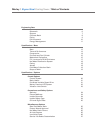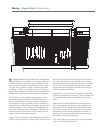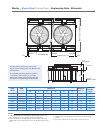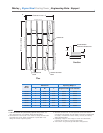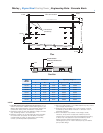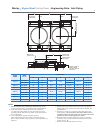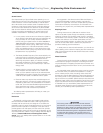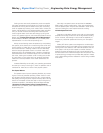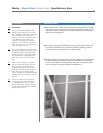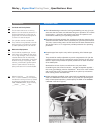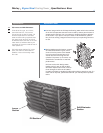
Marley
/
Sigma Steel Cooling Tower
/
Engineering Data: Environmental
10
Sound Control
Sound produced by a Sigma Steel tower operating in an un-
obstructed environment will meet all but the most restrictive
noise limitations—and will react favorably to natural attenu-
ation. Where the tower has been sized to operate within an
enclosure, the enclosure itself will have a damping effect on
sound. Sound also declines with distance—by about 5 dBA
each time the distance doubles. Where noise at a critical point
is likely to exceed an acceptable limit, several options are
available—listed below in ascending order of cost impact:
• Inmanycases,noiseconcernsarelimitedtonighttime,
when ambient noise levels are lower and neighbors are
trying to sleep. You can usually resolve these situa-
tions by using two-speed motors in either 1800/900 or
1800/1200 RPM configuration—operating the fans at
reduced speed without cycling “after hours”. The natural
nighttime reduction in wet-bulb temperature makes
this a very feasible solution in most areas of the world,
but the need to avoid cycling may cause the cold water
temperature to vary significantly.
• TheMarleyVariableFrequencyDriveautomaticallymini-
mizes the tower’s noise level during periods of reduced
load and/or reduced ambient temperature without
sacrificing the system’s ability to maintain a constant
cold water temperature. This is a relatively inexpen-
sive solution, and can pay for itself quickly in reduced
energy costs.
• Wherenoiseisaconcernatalltimes—forexample,
near a hospital—the best solution is to oversize the
tower so it can operate continuously at reduced (1200
or 900 RPM) motor speed. Typical sound reductions are
7 dBA at 2/3 fan speed or 10 dBA at half fan speed.
• Extremecasesmayrequireinletanddischargesound
attenuator sections—however, the static pressure loss
imposed by attenuators may necessitate an increase in
tower size. This is the least desirable approach because
of the significant cost impact—and because of the
obstruction to normal maintenance procedures.
Your Marley sales representative will help you meet your
sound requirements.
Enclosures
Occasionally, cooling towers are located inside architec-
tural enclosures for aesthetic reasons. Although Sigma tow-
ers adapt well to enclosures, the designer must realize the
potential impact of a poorly arranged enclosure on the tower’s
performance and operation. The designer must take care to
provide generous air inlet paths, and the tower’s fan cylinder
discharge height should not be lower than the elevation of the
top of the enclosure. Obtain a copy of Marley Technical Report
#H-004, “External Influences on Cooling Tower Perfor-
mance” from your Marley sales representative or on the web
at spxcooling.com.
As suggested in the aforementioned Technical Report, it
may also be advisable to specify a design wet-bulb tem-
perature1°Fhigherthannormaltocompensateforpotential
recirculation initiated by the enclosure. You’ll benefit from
discussing your project with your Marley sales representative.
Keeping It Clean
Cooling towers are very effective air washers. Atmo-
spheric dust able to pass through the relatively small louver
openings will enter the circulating water system. Increased
concentrations can intensify system maintenance by clogging
screens and strainers—and smaller particulates can coat
system heat transfer surfaces. In areas of low flow velocity—
such as the cold water basin—sedimentary deposits can
provide a breeding ground for bacteria.
In areas prone to dust and sedimentation, you should con-
sider installing some means for keeping the cold water basin
clean. Typical devices include side stream filters and a variety
of filtration media.
Water Treatment
Contaminants including Legionella, an effective consistent
water treatment program is required. Controlling blowdown
may be adequate in mitigating the potential of corrosion and
scale, but biological contamination can only be controlled with
biocides.
An acceptable water treatment program must be compat-
ible with the variety of materials incorporated in a cooling
tower—ideally the pH of the circulating water should fall
between 6.5 and 8.0. Batch feeding of chemicals directly into
the cooling tower is not a good practice since localized dam-
age to the tower is possible. Specific startup instructions and
additional water quality recommendations can be found in the
Sigma User Manual which accompanies the tower and also
isavailablefromyourlocalMarleysalesrepresentative.For
complete water treatment recommendations and services,
contact your local Marley sales representative.
CAUTION
The cooling tower must be located at such distance
and direction to avoid the possibility of contaminated
discharge air being drawn into building fresh air intake
ducts. The purchaser should obtain the services of a
Licensed Professional Engineer or Registered Architect
to certify that the location of the cooling tower is in
compliance with applicable air pollution, fire and clean
air codes.




